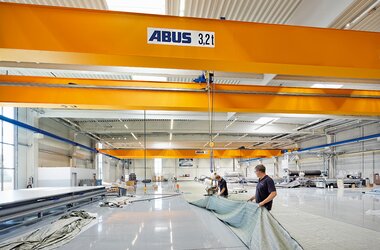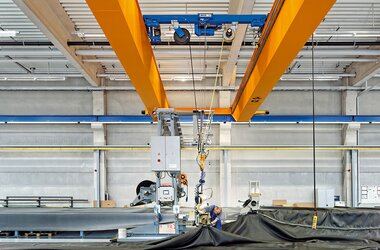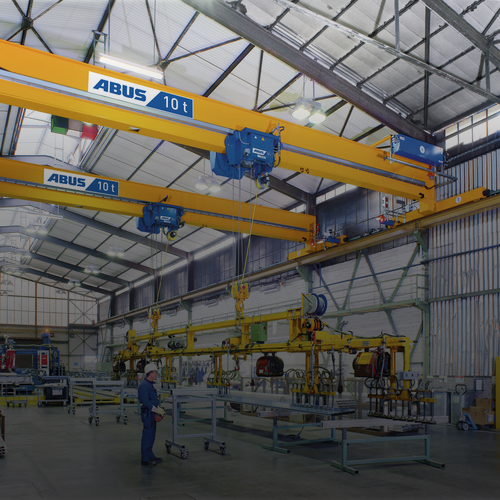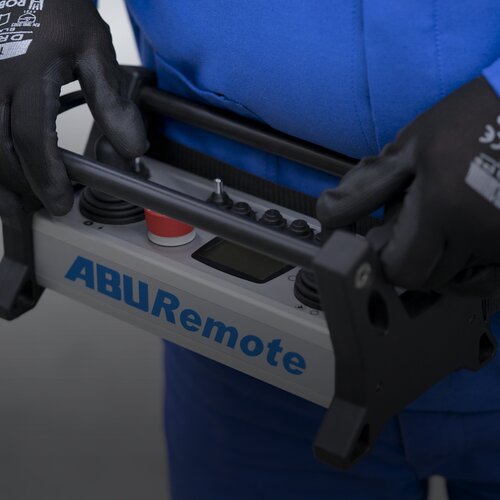HUESKER, l'expert allemand des textiles géosynthétiques techniques accueille des ponts roulants ABUS
The HUESKER group (www.huesker.com) is one of the world's leading manufacturers of geosynthetics and technical textiles. The headquarters of the HUESKER group are to be found in Gescher, a small town in the Westphalia area of Germany. The company is active worldwide through nine daughter companies and an international network of trade and distribution partners in over 60 countries. HUESKER being the pioneers of textile weaving that they are have been actively shaping international markets for more than 150 years. The HUESKER group replace conventional massive construction methods by sustainable and smart solutions in the field of modern and high-performance technical textiles. The products and services of this company create solutions in such varied sectors as earthworks and foundations, roads and pavements, environmental engineering, hydraulic engineering, mining, as well as applications in industry and agriculture.
First-class engineering solutions, a very good competence in the manufacturing, coating and tailoring of technical textiles topped by innovative power are the key to the success of HUESKER. Give them a difficult project and HUESKER will find a solution for you!
It has been thirty years now that ABUS Kransysteme GmbH has been attending to the needs of HUESKER in the areas of intralogistics and transport when it came to developing and expanding their production plants. Up until 2014 ten single girder EOT cranes ELK, one single girder EOT crane ELS, several jib cranes, and an HB system had been supplied. The ABUS agency, company Willmes Fördertechnik, has been responsible for analysing the respective transport tasks for all crane systems in the production and material flow of HUESKER and for advising the customer accordingly. Willmes Fördertechnik has also been involved with the planning of the recent expansion of the production plant. What seemed to be at first a further application for the proven ABUS standard cranes soon turned out to be a crane project with its own challenges for technical and planning engineers. The industrial textiles produced by HUESKER can be up to 90 metres long and up to 36 metres wide and, depending on the application, are sown together by special industrial sewing machines to make long tunnels. During the projecting phase the idea was born to suspend the sewing machines from the crane hooks and to match the speeds of the sewing machines with those of crane and hoist travel. It became clear pretty soon that such an application would only be possible by using frequency-controlled drives. Two double girder EOT cranes ZLK were used with 3.2 t SWL and spans of 37 metres and a sophisticated control. These cranes can operate in normal crane mode for general transport tasks but can also be switched to sewing operation via selector switch and start button. The sewing machines work with compressed air. Thus small compressors were installed on the hoists which create compressed air which is then transmitted to the sewing machines below.
Once this crane system had been successfully commissioned, HUESKER started the next expansion project at their production site at Gescher. This involved the construction of three new production plants and warehouses with lengths of 70 metres which also saw ABUS cranes installed. The first building received two single girder EOT cranes that can operate in tandem via radio remote control. The lifting capacities of these cranes are 2.5 tonnes each and their spans are 23.5 metres. In this building very long textile rolls are transported but also very short ones. The challenge was to design extremely small crane approach dimensions so that the cranes could travel very close together when transporting rolls of very short lengths. The required small approach dimension is achieved by off-centre main girder connections. The cranes are moved apart and operated in tandem when long rolls are transported. The crane operator is able to operate the crane from a safe place while still keeping a close eye on the load and the crane movements thanks to the radio remote control of the crane.














